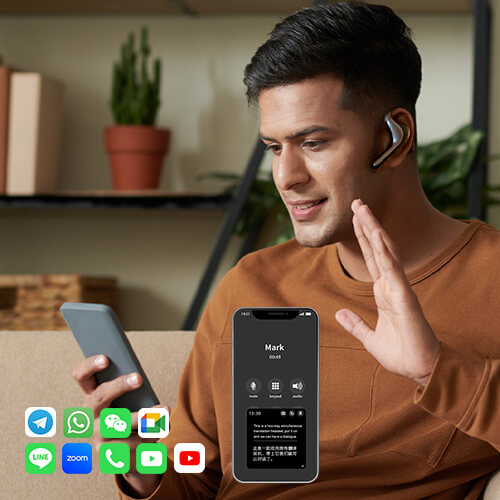
What's the Difference Between a Translator and an Interpreter?
With the very interconnected world we live in today, language can make or break business agreements, lawsuits, and international matters. Millions of individuals require assistance communicating every day between languages. That's where language professionals come in and bridge the gap.
However, where many people tend to get confused is: Should I hire an interpreter or a translator? While both work with languages, these professionals have very different skills and serve unique purposes. Understanding the interpreter vs translator distinction can save you time, money, and potential miscommunication.
What's the Difference Between Translators and Interpreters?
The main difference is simple yet crucial. Interpreters work with spoken language in real-time conversations. Translators work with written documents that they can research and refine over time. This fundamental separation governs every facet of work, from training through working conditions on a day-to-day basis.
Key Similarities and Differences Between Translators and Interpreters

What Interpreters and Translators Share
Interpreters and translators are, respectively, bridges in the global economy today. They have a number of very significant similarities:
- Language mastery is essential. Professionals in this field must be well-versed in source and target language vocabulary, cultural knowledge, colloquialisms, and local idioms.
- Accuracy matters. If it is a transcription of a legal contract or medical appointment, accuracy is foremost. Mistakes will constitute legal or safety problems.
- Continuous learning is vital. Languages are always evolving. Successful professionals continue educating and practicing themselves.
Critical Differences That Matter
The differences between these professions run much deeper than spoken versus written work:
- Timing creates different pressures. Interpreters translate and render speech on the spot, while translators do have the luxury of researching and perfecting it.
- Skill sets vary. Interpreters need skills in listening, swift thinking, and effective oral communication. Translators are proficient researchers, and they are best at analyzing texts
- Work environments differ. Interpreters usually work in busy environments like courts or meetings, while translators usually work in quiet studios or home offices.
Understanding Professional Interpreters
What Interpreters Actually Do
Interpreting is converting spoken communication from one language to another in real-time and it involves complex mental processes happening at the same time.
- Simultaneous interpretation requires listening, processing, and speaking in different languages at the same time. Interpreters at conferences are usually in soundproof booths and usually relieve each other every 20-30 minutes.
- Consecutive interpretation allows the interpreter to listen through entire thoughts prior to translating. It is normally conducted in medical consultations or in sworn depositions.
- Sign language interpretation serves deaf and hard-of-hearing communities, requiring specialized training and certification.
Benefits That Interpreters Provide
Interpreters enable real-time communication across industries:
- Legal settings depend on accurate interpretation. Specialized interpreters are necessary in courts to provide equal hearings to non-English speakers.
- Healthcare interpretation saves lives. Clinical interpreters work alongside doctors and patients, and they directly affect safety and outcomes.
- Business interpretation drives global commerce. International negotiations and business partnership rely on interpreters, bridging the language gap.
Career Requirements for Interpreters
It requires special skills and training to become an interpreter professional:
- Language fluency is foundational. Interpreters need native-level proficiency in cultural understanding in every language.
- Specialized training develops skills. Most employers would like to recruit applicants with formal interpreting training, including ethics, note-taking, and vocabulary.
- Certification opens doors. Court and medical interpreters frequently require certification to establish professional competence.
Travel Opportunities in Interpretation
Travel potential varies by specialization:
- Conference interpreters often travel internationally for events and diplomatic meetings.
- Community interpreters typically work locally in schools, hospitals, and government offices.
- Freelance interpreters can choose their level of travel, depending on client needs.
Professional Translators Explained
The Art and Science of Translation
Translators translate texts, converting from one language to another, maintaining meaning, tone, and cultural context.
- Document translation includes contracts, technical manuals, and medical records.
- Literary translation brings books and creative works to new audiences, requiring both linguistic and creative skills.
- Technical translation focuses on industries like engineering or software, where detailed knowledge of specialized vocabularies is required.
Real-World Translation Applications
Translation work spans virtually every industry:
- Legal translation ensures contracts and agreements work across legal systems.
- Marketing translation adapts campaigns for different cultures, considering values, humor, and norms.
- Website translation helps businesses reach global customers online.
Becoming a Professional Translator
The professional trajectory of becoming a translator is versatile yet challenging:
- Educational background helps. Many employers like linguistics, literature, or the like, but sometimes experience takes its place.
- Portfolio development proves skills. New translators are most likely to initiate volunteering or translating limited jobs in order to create portfolios.
- Professional certification adds credibility. Certification testing, administered by the American Translators Association, demonstrates competency.
What Are the Main Types of Translation Services?
- Human translation is the most accurate and culture-specific, best used on critical documents.
- Machine translation is economical and fast in day-to-day communication but not with complicated grammar or cultural complexities.
- Hybrid translation combines machine efficiency with human expertise, balancing speed and accuracy for large projects.
Related reading: Types of Translation and Approaches for Effective Global Communication
Can Someone Work as Both Interpreter and Translator?
Many professionals develop skills in both areas, though most specialize:
- Complementary skills enable dual careers, with core language skills being transferable between the two careers.
- Different demands often lead to specialization, as interpretation requires real-time processing while translation focuses on research and refinement.
- Market opportunities can prompt diversification, especially among freelancers.
Salary Expectations for Language Professionals
Compensation varies by specialization, location, and experience:
- Translator salaries range from $40,000 to $80,000 annually, with higher rates for specialized fields. An US Legal Translation average annual salary is $55,419.
- Interpreter earnings vary widely. Court interpreters may earn $25-50 per hour, while conference interpreters can command $500-800 per day. The interpreters in the US earn an average hourly wage of $31.89
- Geographic factors impact earnings, with metropolitan areas offering more opportunities and higher pay.
Growing Demand for Language Professionals
Industry Growth Drivers
There are several trends behind the need for translators and interpreters:
- Global business expansion creates constant need for language services.
- Immigration patterns drive community interpretation needs in healthcare, education, and government.
- Digital content explosion increases demand for translation in streaming, apps, and online platforms.
Technology's Impact on the Field

Technology is reshaping the industry:
- Remote interpretation went mainstream during the COVID-19 pandemic through enabling the interpreters to work remotely.
- AI translation tools are yet being perfected but haven’t replaced experts yet, but are great assistance. For example, Timekettle's latest product, the W4 pro AI translation earphones, can be used conveniently in global language communication scenarios such as factories, construction sites, business meetings, churches, and schools.
- Specialization becomes more important as basic translation work becomes automated, and the specialists do complex, high-value work.
Conclusion
The choice between an interpreter and translator depends on your specific needs. If you need real-time communication, hire an interpreter. If you need paperwork translated word by word, then work with a translator.
The two careers present lucrative jobs for people with an interest in linguistics and trans-cultural communication. The rising international economy holds rock-solid demand among professionals to fill communication gaps.
If you are considering working in language services or are tasked with making hiring decisions, knowing about such profound dissimilarities will enable your best selections.
FAQs
Q: How long does it take to become a certified interpreter or translator?
A: Training time varies. Some complete certification programs in 6-12 months, while others may need 2-4 years of study and training.
Q: Do interpreters and translators need to be native speakers of both languages?
A: Native-level fluency is ideal but not required. Professional competency and cultural understanding are essential.
Q: Which language pairs are most in demand?
A: Spanish-English is the highest demand pair in the US, followed by Chinese, Arabic, and Russian. Rare language combinations often pay premium rates.
Q: Can technology replace human interpreters and translators?
A: While AI tools are improving, human professionals remain essential for nuanced or culturally sensitive communication.
Q: What's the difference between interpretation and translation certification?
A: Interpreter certification focuses on real-time skills, often including oral exams. Translation certification involves written tests demonstrating accuracy. Requirements vary by state and specialty.













